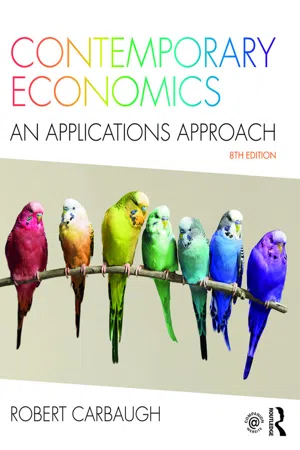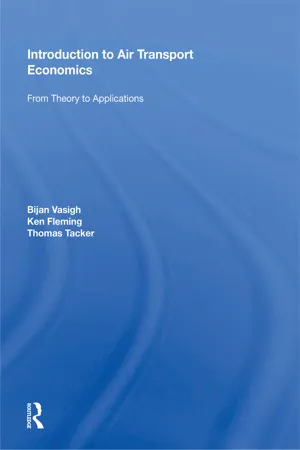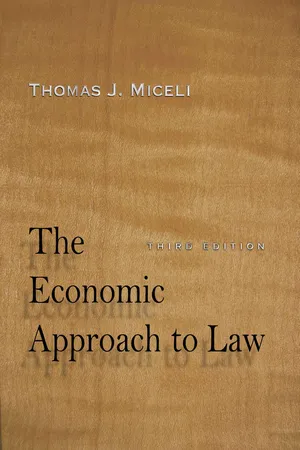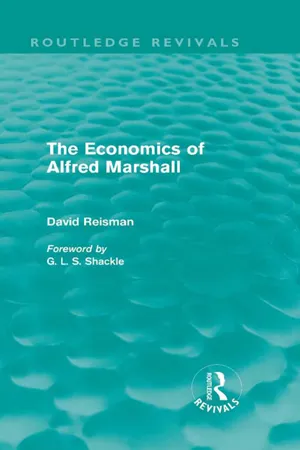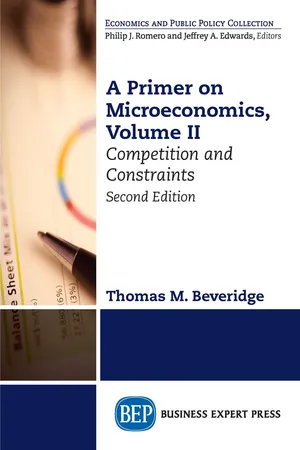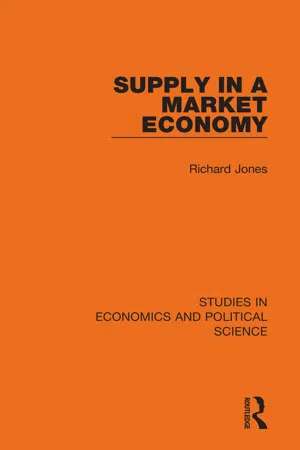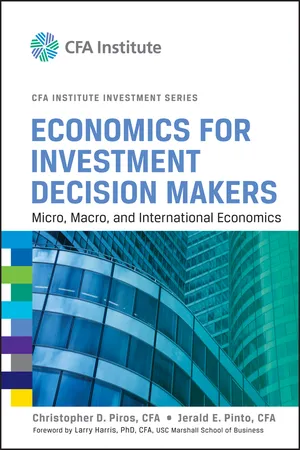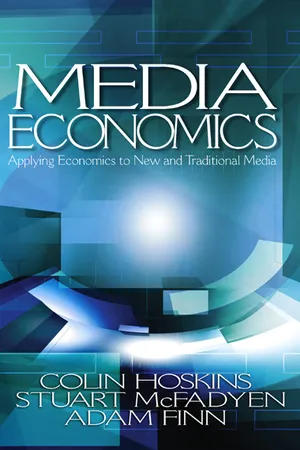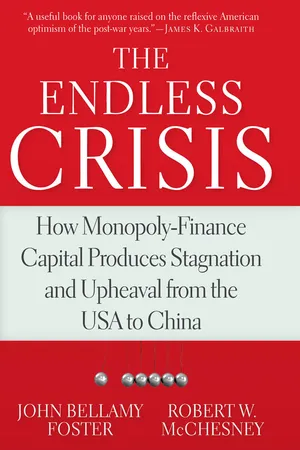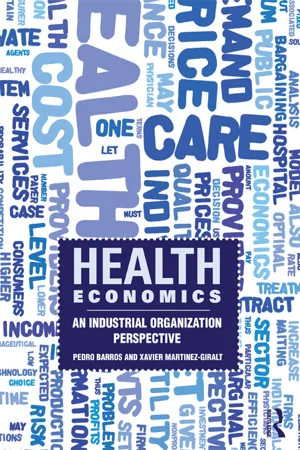Economics
Perfect Competition vs Monopolistic Competition
Perfect competition is a market structure where many small firms produce identical products and have no market power. Monopolistic competition, on the other hand, is a market structure with many firms producing similar but differentiated products, allowing for some degree of market power. In perfect competition, firms are price takers, while in monopolistic competition, firms have some control over their prices.
Written by Perlego with AI-assistance
Related key terms
Related key terms
1 of 4
Related key terms
1 of 3
11 Key excerpts on "Perfect Competition vs Monopolistic Competition"
- No longer available |Learn more
Contemporary Economics
An Applications Approach
- Robert Carbaugh(Author)
- 2016(Publication Date)
- Routledge(Publisher)
Economists have formulated four market classifications to illustrate different competitive situations: perfect competition, monopolistic competition, oligopoly, and monopoly. With perfect competition, competition is strongest; in contrast, competition is nonexistent in a pure monopoly. In the middle is monopolistic competition, which is closer to perfect competition, and oligopoly, which is closer to monopoly.In this chapter, we will examine the virtues and vices of perfect competition and monopoly. The next chapter will consider monopolistic competition and oligopoly.Perfect Competition
Let us begin with perfect competition, the most competitive market structure. A perfectly competitive market is characterized by the following:- Insignificant barriers to entry or exit. New firms can enter a market if it appears profitable or exit if they expect losses. For example, lawn maintenance is an easy market to enter. To enter the market, one needs only a lawnmower, an edger, and perhaps an ad in the local newspaper.
- Many sellers and buyers. Each firm sells or purchases only a negligible share of the total amount exchanged in the market.
- A standardized product produced by firms in the industry. For example, the wheat grown by one farmer is identical to the wheat grown by another farmer. As a result, brand preferences and consumer loyalty are nonexistent.
- Perfect information. All sellers and buyers are fully aware of market opportunities. That is, they know everything that relates to buying, producing, and selling the product.
Perfect competition is quite rare in the United States because most markets do not fulfill all of these assumptions. The usefulness of this market structure is that it serves as an important ideal against which real-world markets can be judged. Some markets, however, come close to fulfilling the assumptions of perfect competition and thus provide an approximation that is characterized by case of entry and exit. Examples include agriculture, the fishing industries, stock markets (such as the New York Stock Exchange), and the foreign exchange market. - eBook - ePub
Introduction to Air Transport Economics
From Theory to Applications
- Bijan Vasigh(Author)
- 2017(Publication Date)
- Routledge(Publisher)
chapter 9 .Table 8.1 Market continuumPerfect Competition
A perfectly competitive industry is one in which there are a large number of small buyers and sellers who can enter and exit the industry with no restrictions. This creates a situation in which the individual firm has little or no power over the price of their good. The price is dictated by the market, and this makes the individual firms price-takers. on this basis, each firm has a simple decision: to sell at the market-bearing rate or not to sell at all.Conditions of Perfect Competition
In order for perfect competition to exist, four conditions must be met. Since very few markets satisfy all four conditions exactly, examples of perfectly competitive markets are limited. Nonetheless, as many industries approximate these conditions, the idea of a perfectly competitive market is a useful construct when comparing market structures. The four conditions are:- homogenous identical product
- many small buyers and sellers
- perfect dissemination of information
- very low barriers to entry.
The first condition for perfect competition is that the product must be relatively homogenous. This condition flows naturally from the idea that buyers of the product should feel that they are receiving essentially the same product (regardless of which seller they purchase from). The more heterogeneous the product becomes, the more sellers can take advantage of their market position. Therefore, we should expect—and, indeed, we see—sellers attempting to differentiate their product in any type of market. However, there are many types of markets, notably those for agricultural products, where it is difficult for sellers to differentiate their product. These markets are generally thought to be good examples of competitive markets. - eBook - ePub
- Thomas J. Miceli(Author)
- 2017(Publication Date)
- Stanford Economics and Finance(Publisher)
The literature on antitrust is vast, so this chapter offers only an overview of some of the key issues, with an emphasis on the insights economic theory can offer. We begin with a review of the economics of perfect competition, which provides a benchmark for measuring the efficiency losses due to monopoly. We then turn to the role of the law in promoting competition.1 Perfect Competition Versus MonopolyA monopoly is defined to be a market that is served by a single seller. The problem of monopoly, and the economic justification for legal intervention to prevent it, is that monopolistic firms set a price and output level that are inefficient, resulting in a loss of welfare. The nature of this loss is best seen in relation to a perfectly competitive market, which, because it allocates resources efficiently, maximizes social welfare.1.1 Competitive Markets and WelfareThe defining characteristic of a competitive market is the large number of firms, which makes it impossible for any one firm to affect the market price. For this reason, we say that firms are price takers . Figure 10.1 illustrates the determination of equilibrium price and quantity in a competitive market. The left panel shows the market output and price, which is determined by the intersection of the supply and demand curves. At this point, the amount of the good that consumers want to buy at the market price exactly equals the aggregate amount that producers supply to the market. The right panel of Figure 10.1 shows the corresponding output of an individual firm, q *, which occurs where the equilibrium price of the good (the firm’s marginal revenue, which it takes as given), equals its marginal cost, or where P * = MC .1The outcome depicted in Figure 10.1 - David Reisman(Author)
- 2013(Publication Date)
- Routledge(Publisher)
2 and that there is more merit in being fuzzily right than in being precisely wrong. In his ambiguous and open-ended way he seems to have treated all four of the principal market structures that figure in contemporary economics textbooks, and it is with these four market structures that we shall be concerned in the four sections of the present chapter.6.1 PERFECT COMPETITION
The theoretical analysis of perfect competition, Stigler says, was long treated ‘with the kindly casualness with which one treats of the intuitively obvious’: ‘It is a remarkable fact that the concept of competition did not begin to receive explicit and systematic attention in the main stream of economics until 1871.’1 Economics rapidly made up for lost time and extensive definitions may be found in books such as Jevons' Theory of Political Economy (1871) and Edgeworth's Mathematical Psychics (1881).2 Marshall's own definition is as follows: ‘A perfect market is a district, small or large, in which there are many buyers and many sellers all so keenly on the alert and so well acquainted with one another's affairs that the price of a commodity is always practically the same for the whole of the district.’3 In such a market, ‘buyers generally compete freely with buyers, and sellers compete freely with sellers’,4 and the outcome of such ‘free competition’ is precisely what we would anticipate: there is ‘only one price on the market at one and the same time’ and no dealer is driven to ‘taking a lower or paying a higher price than others are doing’.5 Always assuming, of course, that four conditions implicit in the definition of the perfect market are satisfied.First , product homogeneity. We must assume that ‘the commodities referred to are always of the same quality’.6 This is the case, for example, with ‘raw produce’ (including the ubiquitous fresh fish), and also with some manufactured outputs - as where the goods in question are ‘so simple and uniform’, so ‘plain and common’, that their production ‘can be reduced to routine’ and their distribution can be ‘wholesale in vast quantities’ (goods like, say, ‘steel rails and calico’ which are available at a multiplicity of different outlets).7 Homogeneity in the sense of the economist must not, however, be confused with homogeneity in the sense of the physicist, as Marshall reflected in an important footnote on the subjective and the objective which occurs in his fragmentary Essay on Value and which reads as follows: ‘Inequalities of price are indeed often more apparent than real. A man who pays four shillings for a pair of gloves which he knows he could have bought in the next street for three, pays three shillings for the gloves and expends the fourth on love of display, on indulgence of old associations, or saving of time. He buys something extra just as much as if the gloves had had extra fancy work upon them.’8- eBook - ePub
A Primer on Microeconomics, Second Edition, Volume II
Competition and Constraints
- Thomas M. Beveridge(Author)
- 2018(Publication Date)
- Business Expert Press(Publisher)
CHAPTER 8 Between Perfect Competition and MonopolyChapter Preview: In Chapters 5 and 6 , we set up and examined “perfect competition,” a model of a market that assumes many firms with free entry into the market. We discovered that, in general, perfectly competitive markets serve society’s needs very effectively. In Chapter 7 , we moved to the other extreme, looking at “monopoly” industry, wherein there is only one firm, which preserves its unique position through the imposition of substantial barriers to entry. With some qualifications, we concluded that monopoly does not usually serve society well.By the end of this chapter, you will be able to:• Identify the features of a monopolistically competitive firm and industry.• Define product differentiation and explain how it occurs.• Explain why the monopolistically competitive firm will make only normal profits in long-run equilibrium.• Identify and analyze the factors in monopolistic competition that cause inefficiency and resource misallocation.• Identify the characteristics of an oligopolistic firm and industry.• Discuss the behavioral implications of the cartel model and the price leadership model.• Outline the kinked demand curve model and explain how it explains price stickiness.• Describe ways in which an oligopolistic industry may be inefficient.• Describe how the contestable market model affects the perspective on oligopolistic inefficiency.• Use game theory to analyze the strategies available to rivals in a two-person game.• Explain what the Herfindahl-Hirschman Index is and how it is used in antitrust cases.When you visit the food court at your local mall, dozens of businesses vie with one another to attract you (and your wallet). Similarly, clothing stores, shoe stores, and electronics stores await beyond the food court. None of these firms is perfectly competitive; none is a monopoly. The presence of advertising and brand names places these firms outside the perfectly competitive model and the presence of close substitutes places them beyond the bounds of pure monopoly. These firms are either monopolistically competitive or oligopolistic in nature. What distinguishes firms such as these, and how well do they cater to our needs? - eBook - ePub
- Rob Dransfield(Author)
- 2013(Publication Date)
- Routledge(Publisher)
Some goods are identical (or almost identical) in nature – for example, bags of white sugar. Other goods are highly differentiated – for example, works of art painted by skilled and celebrated artists. The more sellers there are, the higher the level of competition.Freedom of entry and exitSome markets are difficult to enter. For example, many professions, such as medicine, involve high skill levels so there are relatively few practitioners. Other markets are easy to enter – for example, setting up a small grocery store. The greater the ease of entry the more intense the competition.Controls on priceIn most markets firms compete with each other through the prices they charge. However, in monopoly markets the monopolist is able to set prices. In some instances the government also sets price controls in the form of maximum prices that sellers can charge.5.4 Perfect competitionAs a way of analysing how businesses compete with each other, economists have developed a theory of perfect competition. Perfect competition does not exist in pure form in the real world because there are always differences between sellers. For example, one street vendor of plain colour t-shirts might be more friendly than another vendor of identical items. - eBook - ePub
- Richard Jones(Author)
- 2021(Publication Date)
- Routledge(Publisher)
It has been argued above that the so-called theory of the firm is more properly described as a theory of market supply, and as such the most widely adopted model is that of the perfectly competitive market. This is the least (descriptively) realistic model which has been developed by economists. It is this characteristic which is felt by critics and supporters to be the greatest weakness and strength of the model, as the case may be. That is to say, it is this feature of the model which has brought it into most disrepute but which, at the same time. is claimed to be its greatest strength. Those who believe that the perfectly competitive model has a significant contribution to make, argue that the economist's main interest in the firm is to derive the industry supply curve and that it is only under conditions of perfect competition that the concept of a supply curve attains the degree of precision and unambiguity necessary to its use in market models of supply and demand. Under conditions of monopoly the supply curve has a special and restricted meaning, while under conditions of monopolistic competition the concept of the industry is itself in a somewhat nebulous position.II. Perfect Competition1
The conditions necessary to the existence of a perfectly competitive market are as follows: a homogeneous product, a large number of relatively small producers, perfect information in the market place, and free and easy exit and entry into the market. Under these conditions no individual producer can influence the price charged in the market, nor can abnormal profits exist in the long run.2 Price is determined by the market and all producers are price takers; that is, the conditions described guarantee an impersonal market in which the forces of supply and demand rule. It will be appreciated that the phrase 'a competitive market' has rather a special meaning in economics. The economist would not use this expression to describe the market for washing powders, for example. The businessmen operating in that market, however, most probably feel that their market is intensely competitive.The short-run behaviour of the firm in a perfectly competitive market will now be considered. Input prices are taken to be fixed. The objective of the firm is to select that rate of output at which profits will be maximised. Price will be simultaneously determined, of course. It can be argued with some force that it is incorrect to dignify this procedure as taking a pricing decision. Price is determined by the market and profit maximisation is a condition of survival. - eBook - ePub
Economics for Investment Decision Makers
Micro, Macro, and International Economics
- Christopher D. Piros, Jerald E. Pinto(Authors)
- 2013(Publication Date)
- Wiley(Publisher)
Exhibit 4-1 :Schumpeter on Innovation and Perfect CompetitionThe Austrian-American economist Joseph A. Schumpeter* pointed out that technical change in economics can happen in two main ways:1. Innovation of process: a new, more efficient way to produce an existing good or service. 2. Innovation of product: a new product altogether or an innovation on an existing product.Innovation of process is related to production methods. For example, instead of mixing cement by hand, since the invention of the electric engine it has been possible to use electric mixers. A more recent innovation has been to use the Internet to provide technical support to personal computer users: a technician can remotely log on to the customer’s PC and fix problems instead of providing instructions over the phone. The result is likely the same, but the process is more efficient.Innovation of product is related to the product itself. MP3 players, smart phones, robot surgery, and GPS vehicle monitoring have existed for only a few years. They are new products and services. While portable music players existed before the MP3 player, no similar service existed before GPS monitoring of personal vehicles and freight trucks was invented.How does the reality of continuous innovation of product and process, which is a characteristic of modern economies, fit into the ideal model of perfect competition, where the product is made by a huge number of tiny, anonymous suppliers? This seems a contradiction because the tiny suppliers cannot all be able to invent new products—and indeed, the markets for portable music players and smart phones do not look like perfect competition.Schumpeter suggested that perfect competition is more of a long-run type of market. In the short run, a company develops a new process or product and is the only one to take advantage of the innovation. This company likely will have high profits and will outpace any competitors. A second stage is what Schumpeter called the swarming (as when a group of bees leaves a hive to follow a queen): In this case, some entrepreneurs notice the innovation and follow the innovator through imitation. Some of them will fail, while others will succeed and possibly be more successful than the initial innovator. The third stage occurs when the new technology is no longer new because everyone has imitated it. At this point, no economic profits are realized, because the new process or product is no longer a competitive advantage; everyone has it—which is when perfect competition prevails and we have long-run equilibrium until a new innovation of process or product is introduced. - eBook - ePub
Media Economics
Applying Economics to New and Traditional Media
- Colin Hoskins, Stuart M. McFadyen, Adam Finn(Authors)
- 2004(Publication Date)
- SAGE Publications, Inc(Publisher)
Such nonprofit goals would be impossible to pursue at the expense of profits under perfect competition (or monopolistic competition). Even under other industry structures, such as monopoly or oligopoly, financial breakeven must be achieved for the organization to survive; hence sources of revenue must be explored and the operations conducted in a cost-efficient manner. Even an auteur needs to eat. In the case of Egoyan, availability of public (government) funding for production and distribution of Canadian films has facilitated the pursuit of nonprofit goals.8.3.6 Diversity of ViewsA major concern with monopoly in the mass media is the effect on diversity of opinion. Democracy works best when many independent voices are heard. It is thus a problem if, for example, the number of newspaper chains dwindles or the growth of media conglomerates results in cross-ownership. For example, a person living where the same company owns the local newspaper, the television station, and one of the radio stations is not likely to be exposed to a wide range of editorial opinion. However, there is no product differentiation under perfect competition, so the same concern applies to this industry structure.8.4 SummaryIn this chapter, we examined perfect competition and monopoly, the market structures at the opposite ends of the scale in terms of competitiveness.In perfect competition, because there are many small firms producing an identical product, market price is determined by the interaction of industry supply and demand. Firms have to accept this price but can adjust their output to that at which mr = MC. In the short run, firms will produce as long as, at the output where mr = MC, average revenue (equal to price) is greater than average variable cost, and thus units produced at least contribute toward unavoidable fixed costs. Conversely, if average revenue is less than average variable cost, the firm should close its plant. This produce–shut-down criterion also applies to other industry structures.The lack of barriers to entry means that perfectly competitive firms can only earn zero economic profits in the long run. If positive economic profits are earned in the short run, this is the signal for new firms to enter the industry. The entry of new firms expands industry supply and causes price to decrease until economic profit is reduced to zero. How far price falls depends on cost conditions; that is, whether the industry experiences constant cost, increasing cost, or decreasing cost as output expands. - eBook - ePub
The Endless Crisis
How Monopoly-Finance Capital Produces Stagnation and Upheaval from the USA to China
- John Bellamy Foster, Robert W. McChesney(Authors)
- 2012(Publication Date)
- Monthly Review Press(Publisher)
Perfect competition was then brought in as the real content of competition and as a “first approximation” to the real world of competition. While “workable competition,” as it prevailed in the economy, was depicted as essentially in reality what perfect competition was in pure theory: i.e., an economy that operated as if numerous small firms constituted the representative case. He concluded: “The popularity of the concept of perfect competition in theoretical economics is as great today as it has ever been.” 72 At the same time, operating from the opposite tack, a Chicago School argument on the positive aspects of monopoly, building on Stigler’s 1968 The Organization of Industry, was developed. This approach invariably saw monopoly power as (1) reflecting greater “efficiency”; (2) collapsing quickly and reverting to the competitive case; and (3) involving short-term monopoly profits that were eaten up in advance by the costs of obtaining a monopoly. Monopoly was thus naturally fleeting and rapidly turned into competition, so it could be ignored. This was accompanied by a considerable rewriting of history, with Stigler and his colleagues, for example, attempting to deny the predatory pricing policies that had led to the rise to dominance of Rockefeller’s Standard Oil. 73 In general, neoclassical economics in the era of neoliberal triumph, beginning in the late 1970s, promoted versions of economics that eschewed reality for pure market conceptions. Rational expectations theory (in which the ordinary economic actor was credited with absolute rationality, to the point of utilizing higher mathematics in making everyday economic decisions) was designed to deny that government could play an affirmative role in regulating the economy - eBook - ePub
Health Economics
An Industrial Organization Perspective
- Xavier Martinez-Giralt, Pedro Barros(Authors)
- 2013(Publication Date)
- Routledge(Publisher)
ex-ante the overall effect is ambiguous. An empirical appraisal of the question is necessary to solve the ambiguity.Figure 4.8 Monopolistic competition equilibrium.The model of monopolistic competition just described lacks the strategic interaction characterizing the models of oligopoly. Therefore, let us consider that entry restrictions limit the number of active firms in the market, while maintaining all the other features in of Assumption 4.14. This true oligopoly model of product differentiation allows us to study firms’ decision processes where the strategic variable may be either the volume of output (as in the case of homogeneous products) or the price (without obtaining the degenerate outcome found in the case of homogeneous products). Then, a question arises regarding comparing the equilibrium in both cases.To make the analysis tractable, let us follow Singh and Vives (1984). These authors consider a system of linear demand functions and compute the equilibrium in prices and the equilibrium in quantities. It turns out that the equilibrium in quantities leads to higher prices and lower output volumes than the price equilibrium. Singh and Vives then say that competition in quantities is more monopolistic (in the sense that it gives the producers higher capacity to increase the price with respect to the marginal cost, i.e. higher Lerner index) than the competition in prices. Also, the difference in prices between both equilibria depend on the degree of differentiation between the two products.One question remains in the analysis. Given that firms are allowed to choose to compete in prices or in quantities, there are various possible types of competition in the market: both firms may decide (unilaterally) to choose prices; both firms may decide to choose quantities; and one firm may decide to choose the price while the other decides to choose the quantity. Singh and Vives also show that when the two varieties are substitute goods, both firms find it optimal to select quantities as their strategic variable (in the sense that obtain a higher level of profits than with the other three alternatives). This gives consistency to the equilibrium in quantities in the models of oligopoly with product differentiation characterized by the presence of a representative consumer.
Index pages curate the most relevant extracts from our library of academic textbooks. They’ve been created using an in-house natural language model (NLM), each adding context and meaning to key research topics.
Explore more topic indexes
Explore more topic indexes
1 of 6
Explore more topic indexes
1 of 4
